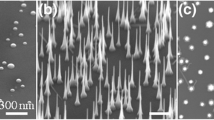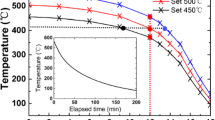Abstract
We have developed an effective strategy for synthesizing p-type indium antimonide (InSb) nanowires on a thin film of InSb grown on glass substrate. The InSb films were grown by a chemical reaction between S b 2 S 3 and I n and were characterized by structural, compositional, and optical studies. Scanning electron microscopy (SEM) and atomic force microscopy (AFM) studies reveal that the surface of the substrate is covered with a polycrystalline InSb film comprised of sub-micron sized InSb islands. Energy dispersive X-ray (EDX) results show that the film is stoichiometric InSb. The optical constants of the InSb film, characterized using a variable-angle spectroscopic ellipsometer (VASE) shows a maximum value for refractive index at 3.7 near 1.8 eV, and the extinction coefficient (k) shows a maximum value 3.3 near 4.1 eV. InSb nanowires were subsequently grown on the InSb film with 20 nm sized Au nanoparticles functioning as the metal catalyst initiating nanowire growth. The InSb nanowires with diameters in the range of 40–60 nm exhibit good crystallinity and were found to be rich in Sb. High concentrations of anions in binary semiconductors are known to introduce acceptor levels within the band gap. This un-intentional doping of the InSb nanowire resulting in hole-dominated transport in the nanowires is demonstrated by the fabrication of a p-channel nanowire field effect transistor. The hole concentration and field effect mobility are estimated to be ≈1.3 × 1017 cm−3 and 1000 cm2 V−1 s−1, respectively, at room temperature, values that are particularly attractive for the technological implications of utilizing p-InSb nanowires in CMOS electronics.






Similar content being viewed by others
References
Adachi S, Miyazaki T, Hamadate S (1992) Optical properties of amorphous InSb. J Appl Phys 71:395–397
Akinlami JO (2014) Optical properties of indium antimonide InSb. The African Rev Phys 9:445–450
Cui Y, Duan X, Hu J, Lieber CM (2000) Doping and electrical transport in silicon nanowires. J Phys Chem B 104:5213–5216
Das SR, Collin CJ, Zakharov D, Chen YP, Sands TD, Janes DB (2011) Room temperature device performance of electrodeposited InSb nanowire field effect transistors. J Appl Phys Lett 98:243504
Dayeh SA, Aplin DPR, Zhou X, Yu PKL, Yu ET, Wang D (2007) High electron mobility InAs nanowire field-effect transistors. Small 3:326–332
Ford AC, Ho JC, Chueh YL, Tseng YC, Fan Z, Guo J, Bokor J, Javey A (2009) Diameter-dependent electron mobility of InAs nanowires. Nano Lett 9:360–365
Hassam S, Rogez J, Bahari Z (2014) Experimental phase diagram of the AuSb–InSb section in the Au–In–Sb system. J Chem Thermodyn 70:168–175
Huang Y, Duan X, Cui Y, Lieber CM (2002) Gallium nitride nanowire Nanodevices. Nano Lett 2:101–104
Iwamura Y, Watanabe N (1992) Epitaxial growth of InSb on semi-insulating GaAs by low pressure MOCVD. J Cryst Growth 124:371–376
Khan MI, Penchev M, Jing X, Wang X, Bozhilov KN, Ozkan M, Ozkan CS (2008) Electrochemical growth of InSb nanowires and report of a single nanowire field effect transistor. J Nanoelectron Opto 3:199–202
Kuo CH, Wu JM, Lin SJ, Chang WC (2013) High sensitivity of middle-wavelength infrared photodetectors based on an individual InSb nanowire. Nanoscale Res Lett 8:327– 334
Levinshtein M, Rumyantsev S, Shur M (1996) Handbook series on Semiconductor Parameters, Chapter 2 World Scientific Publishing Co. Pte. Ltd. Singapore
Liu HS, Liu CL, Wang C, Jin ZP, Ishida K (2003) Thermodynamic molding of the Au-In-Sb ternary system. J Elect Mat 32:81–88
Moss TS, Smith SD, Hawkins TDF (1957) Absorption and dispersion of indium antimonide. Proc Phys Soc London Sect B 70:776–784
Nair MTS, Lazcano YR, Nair PK (2000) Formation of InSb by annealing Sb2S3-In thin films. J Cryst Growth 208:248– 252
Okimura H, Koizumi Y, Kaida S (1995) Electrical properties of p-type InSb thin films prepared by coevaporation with excess antimony. Thin Sol Films 254:169–174
Paskov PP (1997) Refractive indices of InSb, InAs, GaSb.InAsxSb1-x, and In1-xGaxSb: Effects of free carriers. J Appl Phys 81:1890–1898
Philipose U, Sapkota G, Salfi J, Ruda HE (2010) Influence of growth temperature on the stoichiometry of InSb nanowires grown by vapor phase transport. Semicond Sci Tech 075004:25
Plissard SR, Slapak DR, Verheijen MA, Hocevar M, Immink GWG, Weperen IV, N-Perge S, Frolov SM, Kouwenhoven LP, Bakkers EPAM (2012) From InSb nanowires to nanocubes: looking for the sweet spot. Nano Lett 12:1794–1798
Sapkota G, Philipose U (2014) Synthesis of metallic, semiconducting, and semi-metallic nanowires through control of InSb growth parameters. Semicond Sci Tech 29:035001
Senthilkumar V, Thamilselvan M, PremNazeer K, Narayandass SK, Mangalaraj D, Karunagaran B, Kim K, Yi J (2005) Characterization of p-type In-Sb thin films prepared by vacuum evaporation. Vacuum 79:163–170
Soderstrom JR, Cumming MM, Yao JY, Andersson TG (1992) Molecular beam epitaxy growth and characterization of InSb layers on GaAs substrates. J Semicond Sci Tech 7:337–343
Sturge MD (1962) Optical absorption of gallium arsenide between 0.6 and 2.75 eV. Phys Rev 127:768
Vaddiraju S, Sunkara MK, Chin AH, Ning CZ, Dholakia GR, Meyyappan M (2007) Synthesis of group III antimonide nanowires. J Phys Chem C 111:7339–7347
Vogel AT, Boor J, Wittemann JV, Mensah SL, Werner P, Schmidt V (2011) Fabrication of high-quality InSb nanowire arrays by chemical beam epitaxy. Cryst Gr Des 11:1896–1900
Wunnicke O (2006) Gate capacitance of back-gated nanowire field-effect transistors. Appl Phys Lett 89:083102
Yang Y, Li L, Huang X, Li G, Zhang L (2007) Fabrication and optical property of single-crystalline InSb nanowire arrays. J Mater Sci 42:2753–2757
Yang ZX, Han N, Wang F, Cheung HY, Shi X, Yip S, Hung T, Lee MH, Wong CY, Ho JC (2013) Carbon doping of InSb nanowires for high-performance p-channel field-effect-transistors. Nanosc. 5:9671–9676
Yue LD, Tao LH, Hui SH, Cheng ZL (2013) Effects of rapid thermal annealing on the morphology and optical property of ultrathin InSb film deposited on SiO2/Si substrate. Chin Phys B 22:027802
Acknowledgments
This work was performed in part at the University of North Texas’ Center for Advanced Research and Technology facility.
Author information
Authors and Affiliations
Corresponding author
Ethics declarations
Conflict of interests
The authors declare that they have no conflict of interest.
Rights and permissions
About this article
Cite this article
Algarni, Z., George, D., Singh, A. et al. Hole-dominated transport in InSb nanowires grown on high-quality InSb films. J Nanopart Res 18, 361 (2016). https://doi.org/10.1007/s11051-016-3681-x
Received:
Accepted:
Published:
DOI: https://doi.org/10.1007/s11051-016-3681-x




